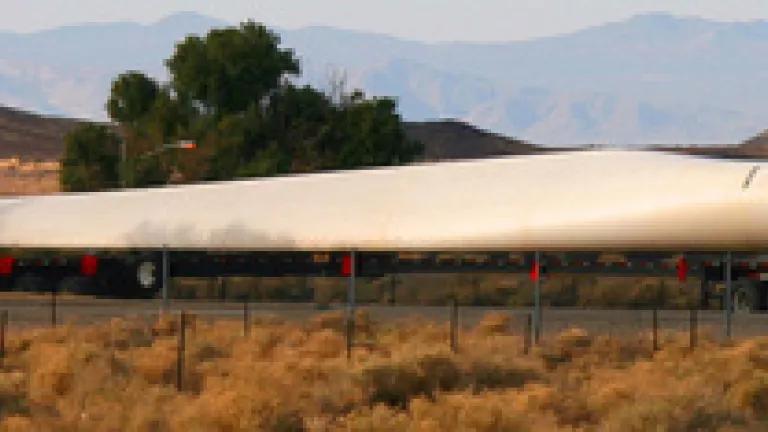
Bill Stovall is a long-haul trucker from Texas. He used to deliver fresh meats and produce, a job he did with pride. But for the past few years, he's been hauling a very different kind of load, in a special, telescoping truck-trailer combo that stretches out to 168 feet. All that length is devoted to carrying a single object: the 130-foot-long blade of a wind turbine. The blade is so long that the driver of his escort van has to uproot stop signs before the truck makes a tight left turn, otherwise the end of blade would lop it off. The rear escort driver has to jump out and replant it.
Wind turbine blade in transit (image courtesy caveman chuck coker via flickr)
For Bill and hundreds of other truckers, hauling super-long blades, 100,000-pound nacelles, and other turbine components from factory to wind farm is all in a day's work. Yet somehow, in the midst of all the political rhetoric we hear about clean energy, the stump speeches about the failure of a single company, the work of people like Bill Stovall--what's really happening on the ground in America--can get lost. The truth is that real change is afoot. Clean energy is here and it is already making a difference in people's lives--incremental, imperfect, and with a few inconveniently-placed stop signs -- yet inspiring.
That's the image Philip Warburg paints in his new book, Harvest the Wind, an on-the-ground look at the wind industry in America. Warburg took a road trip across the country, spending time with people like Bill Stovall, who are working on the front lines of this nascent industry, in communities that are finding new life because of the growth of clean energy.
He talked to Bob Loyd, plant manager for Clipper, a small company that assembles wind turbines in Cedar Rapids, the industrial heart of Iowa. Loyd once supervised the assembly of newspaper printing presses in Cedar Rapids, until the factory shut down. When he got the job at Clipper, Loyd hired several of his former colleagues to join him. Loyd explained his hiring strategy this way: "If you think about a printing press, it's a big gear box with hundreds of gears." Wind turbines, Loyd realized, weren't so different. Clipper now employs about 350 people in Cedar Rapids. (Towns all over the Rust Belt are seeing a similar resurgence in manufacturing jobs as government clean energy and efficiency initiatives take root.)
In Kansas, Warburg visits with savvy farmers like Ray Mason, who spotted a good business opportunity when "the wind boys" came to town. Mason is now pulling in about $50,000 in extra income each year, thanks to wind turbines that occupy what was once marginal grazing land. And it's no small satisfaction to Mason and farmers like him that the industry they're supporting is starting to employ young people in the area, who previously had been leaving in droves.
The stories Warburg shares are tremendously inspiring. These are everyday Americans of all political stripes whose lives have changed because of the advent clean energy. Their communities are gaining jobs, income, and a shot at being part of the new future of energy in America.
Transforming the way we make energy in this country is not a simple endeavor. There will be success stories, and there will be failures. But all along this journey, we are making progress toward a very valuable goal: a clean energy system that protects our health, creates jobs, and makes America independent of foreign energy sources.
